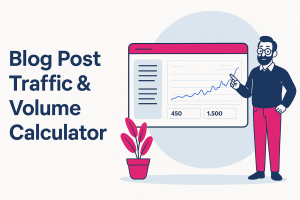If you’re anything like me, headlines are your favorite part of the blog post writing process. They’re the first thing that I read when someone shares an article with me online, and they’re also the first thing that will catch my eye when I’m browsing through a website or search engine result pages. So, it’s important to put some thought into them—and if you’re writing on your own blog, even more so!
Here are some tips for writing great headlines that will ensure more people see and engage with your content:
What Is a ‘Good’ Blog Post Headline?
A good blog post headline is short, but still descriptive. It’s unique, but readable. It’s relevant to the content and engages readers with an intriguing question or promise of what they can expect from your post.
The best headlines are written for people, not search engines.
So, make it human: the most compelling headlines read like a conversation, not a sales pitch. If you can make it feel like there’s a person on the other end, that person will be more likely to read what comes next because it feels more personal—and more human.
You can follow some specific steps to write a better headline in order to increase your online visibility and engagement:
Use Focused Long-tail Keywords
Long-tail keywords are more specific than short or broad keywords and easier to rank for. They’re also more engaging for readers because they’re more targeted. When someone searches for a long-tail keyword, they know exactly what they want.
Because long-tail keywords are so specific and unique, it makes them easy to optimize around as well. That makes them the best option when you write blog post titles because they’re easier for Google’s algorithm to understand without having any context about your content before it loads on their search results page (SERP).
If you’re a pet groomer, for example, instead of going for “dog grooming” or “pet grooming,” think about the actual services that your business offers: “dog nail trimming” or “grooming cats.” These types of keywords are easier to rank for because they’re so specific—and they’ll get more engagement from readers who have a higher chance of being in the market for those services than generic terms like “grooming.
Ensure that you aren’t accidentally doing keyword stuffing by using too many variations on one topic. You want people to find your blog post when they search for certain keywords related to your industry or niche, so make sure those keywords are present in your headline as well as throughout the body of your post itself according to keyword density guidelines set by Google itself.
For example: if I were writing about dog grooming, I could easily write about how important it is for dogs (and cats!) to receive regular baths (or shampoos) as part of their overall care routine . . . but we should make sure that this does not result in some seriously repetitive content.
Focus On A Specific Audience
If you want more engagement with your blog, then it’s a good idea to focus on a specific audience. This is because it allows for more precise content, which in turn gives readers what they want and need.
Write headlines that appeal to your audience’s interests. Your readers are people, and they have specific interests. You can use this knowledge to your advantage in your blog posts by writing titles that speak directly to their needs or align with their passions.
For example, if you’re writing a post about vegan recipes, use words like “vegan” or “plant-based” in the title so that people looking for vegan recipes will be more likely to read it than someone who isn’t interested in vegan eating (and doesn’t want anything other than meat).
The most important thing to understand about your audience is what they want. If you have a blog on gardening, for example, who are your readers? Are they mostly men or women? What age range do they fall into? Where do they live and what kind of work do they do?
You can also try to identify their interests by asking yourself questions like:
- What topics would interest them the most?
- What would make them share my content with others?
Place Your Main Keywords Near The Start
We’ve talked about this before, but it bears repeating: you want to make sure that your main keywords are used in the first few words of your headlines. By putting them at the start, you get more visibility and higher search rankings.
In addition to using your main keyword(s) early on in a headline, consider placing them near the beginning of other sections as well (such as paragraphs). This will help with both engagement and search engine visibility.
Use Niche Keywords
In order to optimize your blog post headlines, it is important to use niche keywords. Niche keywords are more relevant to your audience, which means they will be more likely to convert.
If you go narrow or specific enough in a way that is actually helpful for people looking for something in their search query and it’s not too long of a keyword string (like the example below), then the potential traffic from search results can be huge!
The more you focus in on specific niche the higher your chance of ranking well and picking up attraction.
Build on the keywords, you used in the news module of your Amp campaign: you can use the keywords you selected for your original news article headline and use them in different ways, e.g expanding on them with different phrasing to enhance their impact.
Reflect On Your Content Accurately
Remember the main goal here is to make it readable and engaging while still packing it with targeted keywords. You don’t want to go overboard or you risk losing the reader, but you also don’t want to be too conservative and not use all the words that Google might pick up on.
So what’s a good balance? I recommend using no more than two different types of keywords in your headline: one descriptive keyword phrase and one single word that represents a specific product or service. This way, people will know what they’re clicking on, while also giving Google some context for which terms are most important for your business.
Headlines Make A Difference
Your headline is often the first thing that someone sees about your blog post, so you don’t want to ignore it! You want people who read your headline to click on the link and read more of your content.
It’s clear that headlines have the power to make or break what gets read and shared. That means they deserve a lot of attention and care when you craft them, so don’t just slap anything together! Take the time to pick out words that are sure to attract readers, and think about how those words will fit together grammatically and stylistically as well. You can also tweak your headline as needed once it’s written if something feels off about it—but if you keep these tips in mind from start to end, then we promise your next post won’t be going unnoticed on the internet anytime soon!
Author
-
CEO and Co-Founder at AmpiFire. Book a call with the team by clicking the link below.
Related Posts

How To Optimize Your Headlines To Boost Your Search Engine Rankings, Brand Visibility & Website Traffic?
Headlines are important because they help people to find your content. Since headlines appear on search engine results pages, they’re…

6 Steps To Optimize Your YouTube Videos and 50x Your Traffic & Engagement? [Infographic]
Are you getting the most out of your YouTube videos? Follow these 6 steps to get more engagement, more traffic,…

The 6-Levels Headline Approach For Effective Keyword Selection | How to Create Killer News Article Headlines That Get Traffic & Build Your Brand
By completing all seven steps below, you should have enough keyword ideas to create one or more unique news headline…

How To Find A Unique Topic Angle for Your News Article And Blog Post?
If you are wondering how to find the right topics for your articles then this post is written just for…

Blog Post Traffic & Volume Calculator & Graph
Use this calculator to see exactly when you’ll hit your content goals and outpace competitors. What This Calculator Shows You:…

How to Boost Your eCommerce Brand Exposure: 7 Strategies for Building & Marketing a Successful Online Store [Examples]
When it comes to building a successful eCommerce brand, visibility is key. Whether you sell premium goods or are simply…










